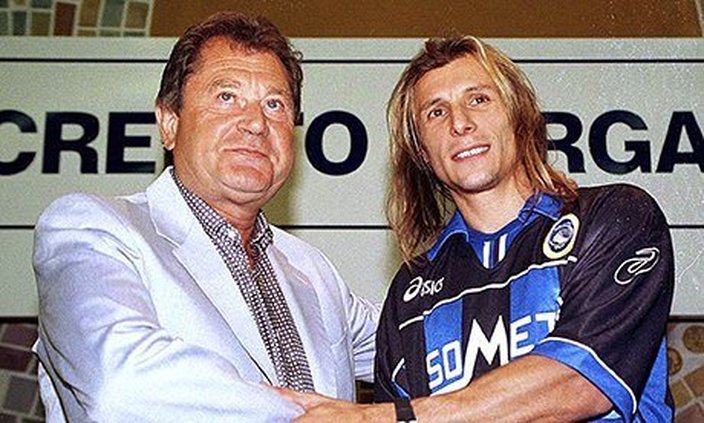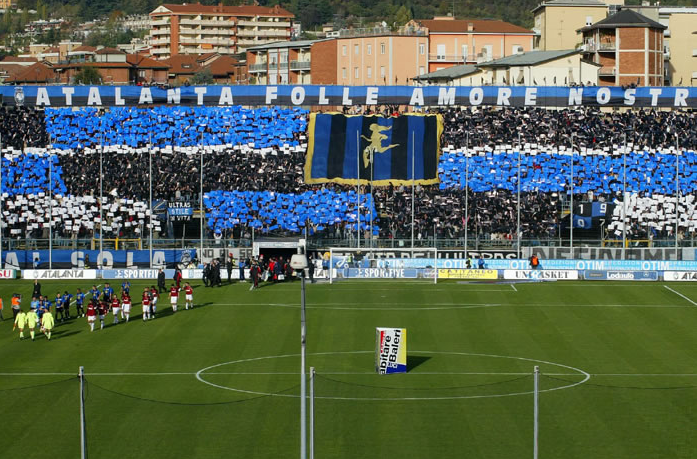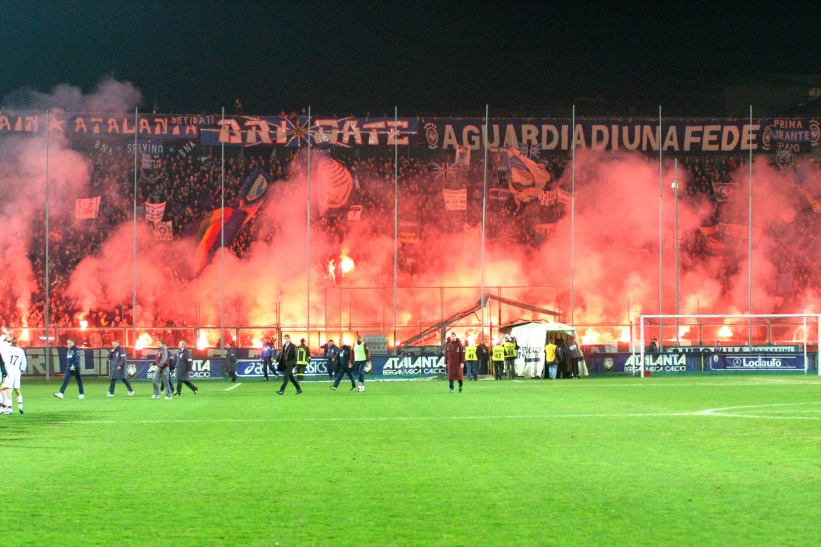Stadium: Stadio Atleti Azzurri d’Italia, Bergamo, capacity 24,642
Atalanta play in the Stadio Atleti Azzurri d’Italia and the atmosphere is one of the most heated in Italy. The ground is often referred to as a relic of Mussolini’s Italy and is now deemed to be fairly outdated. With no roof and some obstructed views there is no doubt that some modernistation would not go a miss, but the atmosphere needs no improvement and Atalanta have some of the loudest and the most loyal fans on the Peninsula. They offer an away day that many opposing teams and fans do not enjoy. The Curva Nord is home to the Ultra group Curva Nord 1907 and they often choreograph displays with flares, huge banners and fireworks. There may be bigger and better stadiums in Italy, but few are as inflammatory as this one can be on match day.
The Ultras
It is July 2013 and the Ultras of Atalanta are partying at their pre-season festival. A tank – yes, a tank – is in the process of crushing both Brescia and Roma. Well not literally, the tank is actually crushing two cars, one painted the white and blue of Brescia and the other painted the red and yellow of Roma.
Fans, family and players have come to join this annual celebration of the football club, known as La Festa della Dea (Festival of the Goddess). On board the tank with a number of Atalanta supporters is new signing Giulio Migliaccio, who later claimed he was “inadvertently the protagonist” in what one might, at first glance, mistake for a tribal celebration of a goddess of war. Actually La Dea is Atalanta and its tribes are the Ultras.
Bergamo, which lies in the shadow of the Alps, is a city of two parts, Upper Bergamo and Lower Bergamo, or in local dialect Berghem de Sura e Berghem de Sota. It is famous for its musical history and enchanting medieval ambience, yet take a trip down to the Stadio Atleti Azzurri d’Italia, and the Ultras of Atalanta compose music of an altogether different pulse.
Atalanta’s Ultras have long been associated with left-wing politics and images of socialist icon Che Guevara could often be seen in the Curva Nord (or Curva Pisani). Their first group, Brigate Neroazzure – black and blue brigade (BNA) – were formed in 1976. Sub-groups such as Wild Kaos Atalanta (WKA), Nomadi (Nomads) andNuova Guardia (New Guard) formed from BNA.
Over the years these Ultras earned themselves a fierce reputation and were renowned for using only “fists” and “boots”. In 1995, following the death of Genoa fan Vincenzo Spagnolo, who was stabbed by AC Milan Ultras, the Atalantini issued a statement entitled “basta lame, basta infami” (“cut out the knives, cut out the infamy”).
In 1998, under the leadership of Claudio “Il Bocia” Galimberti members fromNuova Guardia, BNA, WKA and later the whole of Nomadi came together to formdell’Atalanta Supporters (or Curva Nord Atalanta). This group is now largely apolitical. Il Bocia is well known within the Ultra circle, infamous for his fearless and violent past. Despite this, he greatly respected for his work within the Atalanta and Bergamo community.
As a capofamiglia figure, he organises fundraising and family events such as the aforementioned Festa Della Dea. And the respect does not stop in Bergamo. In 2005, the Ultras of Brescia, Atalanta’s local and fiercest rivals, issued a statement regarding Il Bocia‘s stadium ban: “Nemico leale, Boci non mollare!” (“Bocia our loyal enemy, don’t give up!”).
However, one small group have resisted the call to unite. When the BNA disbanded due to internal conflict regarding ideology and territory on the Curva, some members decided to form Forever Atalanta. These Ultras reside in the Curva Sud, or Curva Morosini, and their members are thought to be predominately leftist.
In recent years the Atalantini have been involved in significant riots and protests. On 11 November 2007, before Atalanta’s game against AC Milan, news travelled to Bergamo that Lazio fan Gabriele Sandri had been shot by police. After seven minutes of play, a pocket of the Curva Nord tried to break down a glass perimeter fence. Players on both sides attempted to calm fans but they were warned that the violence would continue if the game was not abandoned.
There were two notable protests in 2009. The first concerned the club and captain Cristiano Doni’s role in a matchfixing scandal, the second was a protest in Rome opposing La Tessera Del Tifoso (ID cards for football fans). Neither Curva Nord nor Forever Atalanta have accepted La Tessera, and are therefore unable to follow Atalanta on the road.
Atalanta’s Ultras have few friends and many enemies, a fact they thrive on. “Ci stanno sul cazzo tutti” (“we hate everybody”), as Il Bocia aptly puts it. The stabbing of three Atalantini by Roma fans in 2006 has created a particularly heated rivalry. The few “friends” they have include Ternana and Eintracht Frankfurt, based on old political affinities.
On match days the Curva Pisani is a concoction of flares, smoke, flags and banners. On special occasions it is engulfed by a huge blue and black flag. The infamous standing of the Atalanta Ultras lives on and although their reputation has been earned through many a bloody battle they are also admired for upholding Ultra values and their close relationship to the Bergamo community.
As Il Bocia puts it: “What Ultras do is bring the city together. It is our duty to preserve the real values of this sport and while we are around, we will carry that passion forward till the bitter end.”
Classic Player: Claudio Caniggia

El Hijo del Viento (Son of Wind) was the justifiable nickname bestowed on one of the quickest players in Serie A in the early 1990s. There was not a more electrifying sight than seeing Claudio Caniggia in full flight, floating past defenders with a graceful ease.
The Argentinian began his Serie A career at Hellas Verona in 1988 and went on to play for Roma, but he is remembered for his time with Atalanta, where he played 102 games and scored 27 goals in two spells (1989-1992 and 1999-2000).
Caniggia was extremely quick, with an ability to glide from deep, shimmying past defenders and then providing ice cool finishes, normally followed by white hot celebrations. He is best remembered for his goal against Brazil in the second round of Italia 90, a goal which he described as “the most important goal of my career, because we were really on the back foot and because of the rivalry we have with them”.
Fans of the Italian game who can recall those heady days in the early 1990s remember a player with breathtaking pace and long blonde hair that flowed in the wind as he darted forward, but he was also a poacher with great ability in the air.
Claudio Caniggia was unforgettable. During a time when Calcio ruled the world, he had his own special place in it.


